A Taste of Highdown – Afternoon Cream Tea
Dates:
- 2023’s event has now happened – thank you to all that came along
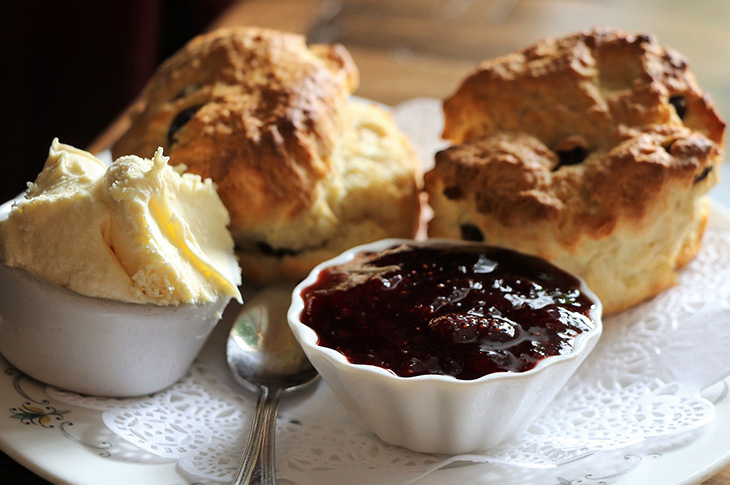

A Taste of Highdown – Afternoon Cream Tea
Dates:

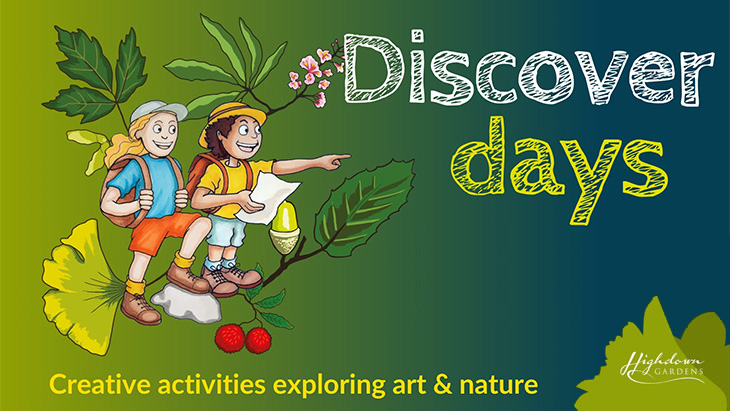
Thank you to all that came along to our last Discover Day on Wednesday, 24th July 2024.
We hope you had a great time!
Discover Days will be back soon – watch this space for details …
You can also access our trails and activity packs … these are free resources funded by the National Lottery including Highdown’s Plant Hunter Trail, Junior Tree Trail, Explorer Cards and the Town to Down Walks which can all be downloaded and printed free of charge:
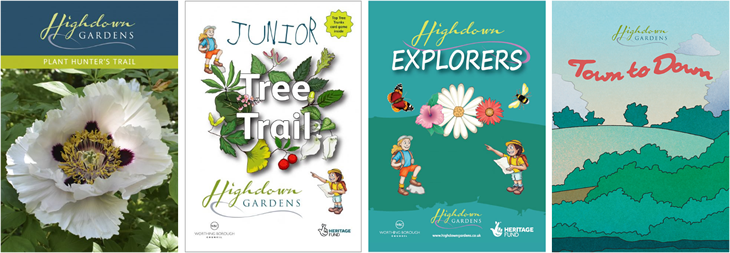
Thank you to Figment Arts, the Chalk Cliff Trust and Worthing Borough Council for their support with our Discovery Days 2024.




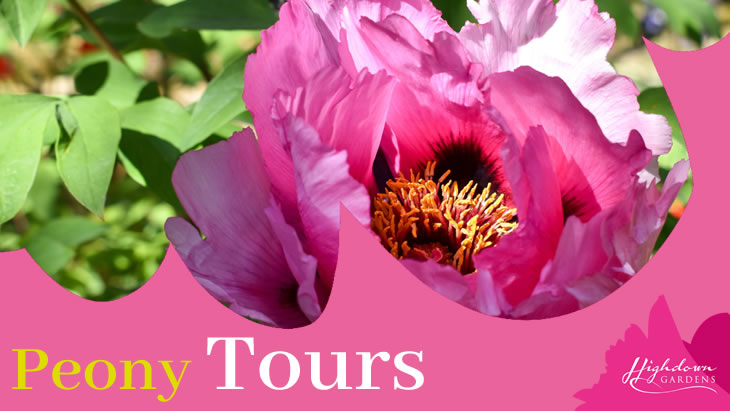
Highdown Gardens beautiful peony collection tours
Sir Fredrick Stern, creator of the gardens, had a particular love for peonies and not only bred them at Highdown, but wrote a monograph called ‘The Study of the genus Peonia’ in 1946 and out of all the plants he admired, peonies were amongst the ones he most experimented with.
Dates:
See also:


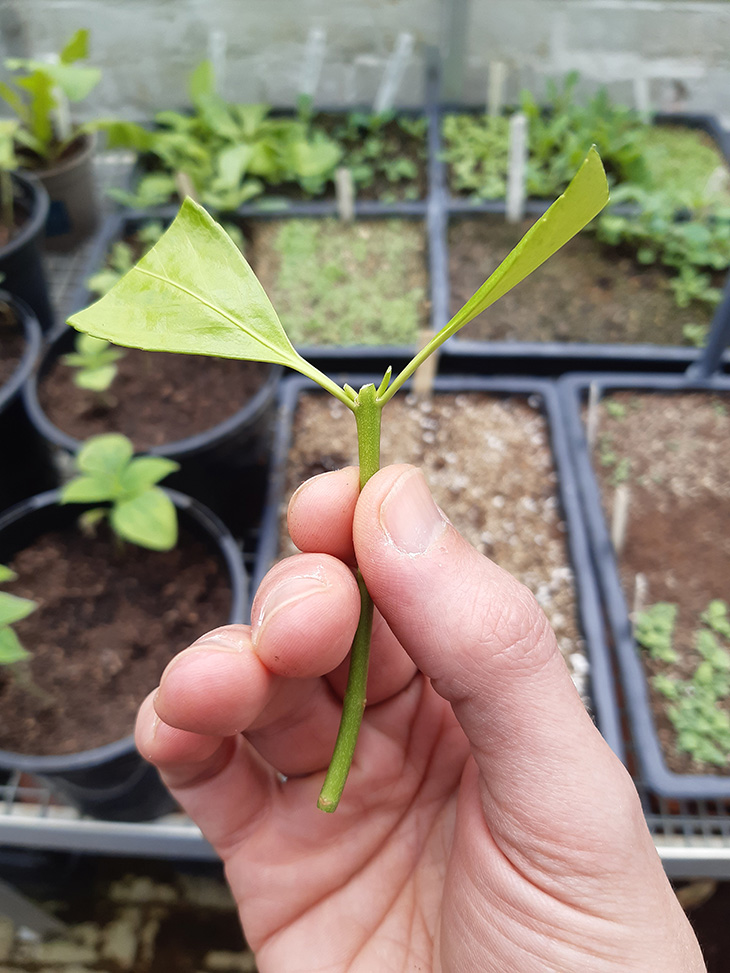
Know & Grow: Softwood Cuttings Workshop
2023’s event has now happened – thank you to all that came along.
To enquire about future Softwood Cuttings Workshops, please email:
Photo: Know & Grow Cuttings Workshop
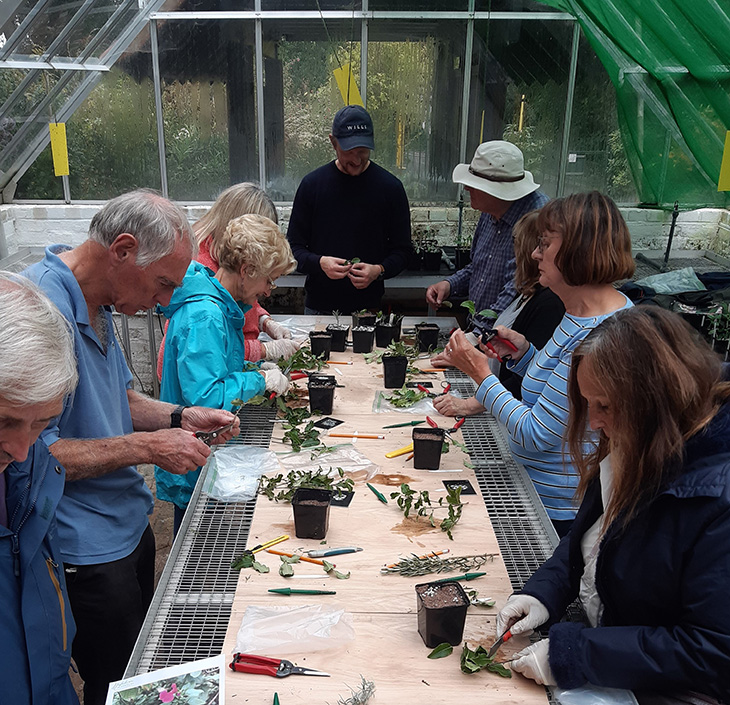


Lisa, our Craft Gardener, talks about glasshouse activity at Highdown Gardens.
It’s been busy in the glasshouse at Highdown Gardens these past few months, there has been a lot of activity with sowing annuals, thinning out, pricking out seedlings, potting on, hardening off and planting out of young plants.
Beds in the Sensory Garden have been full of Daffodils which are now making way for Purple Sensation Alliums which will flower mid May. Two of the beds in particular are full of Alliums which will be beautiful end of May, however they will leave lots of bare areas when they die down.
This is why it’s important to start sowing seeds early in the year. Annuals were first sown in January and have been successionally sown every month since. Fragrant Sweetpeas, very tall and dark purple Scabious atropurpurea, bright orange Calendula, vivid blue Salvia viridian and various colours of different types of Cosmos and Nicotiana are just some of the seeds sown in our glasshouse.
Interesting named ‘Orange King’ and ‘Jelly Bean’ Californian poppies were directly sown in one of the raised beds in the Sensory Garden earlier this month, as they don’t like to have their roots disturbed.
When the Calendula seedlings were large enough they were planted directly out in the Sensory Garden, also in April. Calendula have readily self seeded in the garden in the past and survived, so it is hoped the rabbits won’t eat these young, delicate seedlings.
With trays of new seeds, growing seedlings and pricked out seedlings taking up lots of space in the glasshouse, we are trying to make space, so plants are planted out as soon as they are ready. Including plants which were overwintered in the glasshouse.
Pelargonium and Salvia cuttings which were taken early November last year are now lush and green. They were hardened off for a few weeks by placing them outside and bringing them back into the glasshouse at the end of the day, they were ready to plant out end of this month.
Dahlia tubers were dug up in the Autumn, dried and stored in the glasshouse over winter in crates loosely packed with shredded newspaper. In February the Dahlia tubers were planted in compost in pots and watered regularly in the glasshouse. It was very joyful to see the fresh green growth from the dry brown tubers. When there was plenty of green growth they were planted out in April, making more room in the glasshouse.
Rabbits are a big problem at Highdown Gardens but especially in the Sensory Garden, they enjoy eating new growth, young plants and the bark on young woody shrubs. This is why you’ll see chicken wire circling many plants around the garden. The small Cosmos plants recently planted out are protected by chicken wire, for example, otherwise they would be eaten by the rabbits. Other small plants planted out in April, Sweetpeas and Scabious atropurpurea, were mostly planted in raised beds, which we fortunately have in the Sensory Garden, so they will be left alone by the rabbits.
The future plan for the Sensory Garden is to determine plants and seedlings which will be left alone by rabbits and focus on propagating these. In the meantime we’re busy preparing annuals to fill beds and gaps ready for the summer.
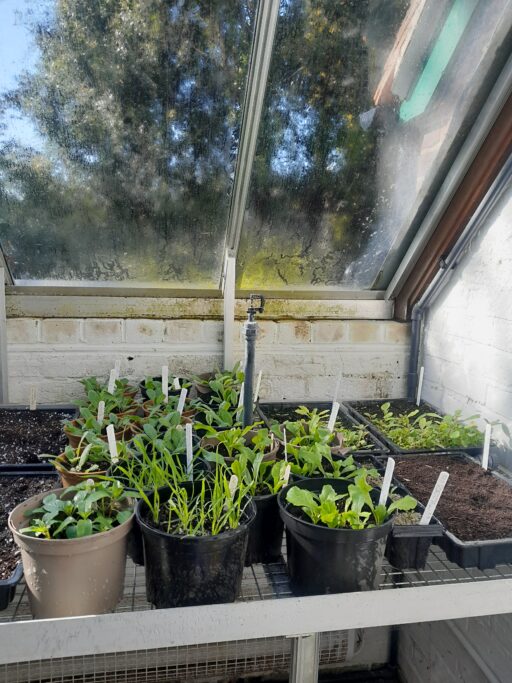
Established seedlings pricked out from seed trays to pots.

Hardening off young plants just outside the Glasshouse, before planting. Calendula, Cosmos, Sweetpeas, Salvia and Pelargoniums.
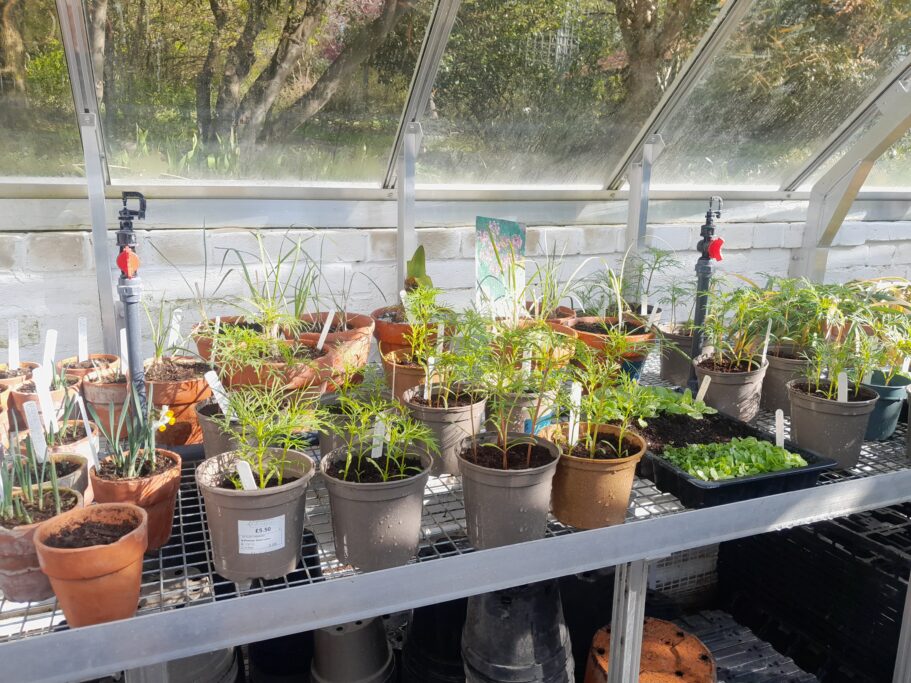
Different varieties of Cosmos seedlings pricked out into pots.
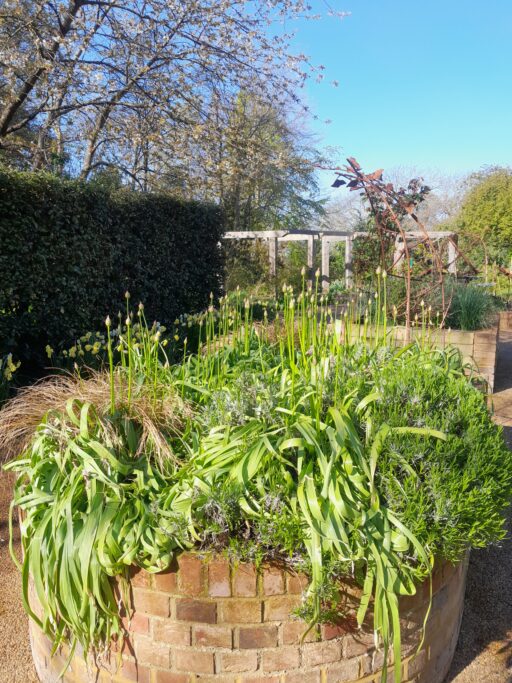
A raised bed in the Sensory Garden full of Purple Sensation Alliums ready to open.
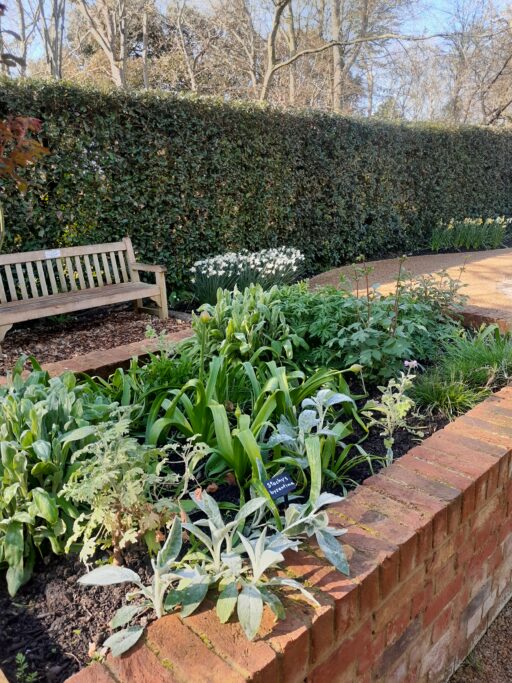
Colourful Dahlias and scented Pelargoniums planted in one of the raised beds in the Sensory Garden.

When: Last Thursday of every month (March to August)
Time: 2pm to 3pm
Price of tour: £5 per person (children under 12 go free)
Please arrive at Highdown Gardens Visitor Centre 5 minutes before the start time of your tour where your guide will greet you.
A unique chance to discover Highdown Gardens’ rich heritage, learn about the garden’s origins, its creators and VIP visitors, as well as spot the garden’s seasonal star plants.
These tours are delivered by Highdown staff and Tour Guide Volunteers.
All proceeds go back into Highdown Gardens Trust, focusing on preservation, education and recreation, providing a legacy for future generations.
There may be tickets available on the day, however we recommend pre-booking online to avoid disappointment.
Book tickets:
Book tickets for a Guided Tour
Highdown Gardens are free to enter as per usual.
See also:

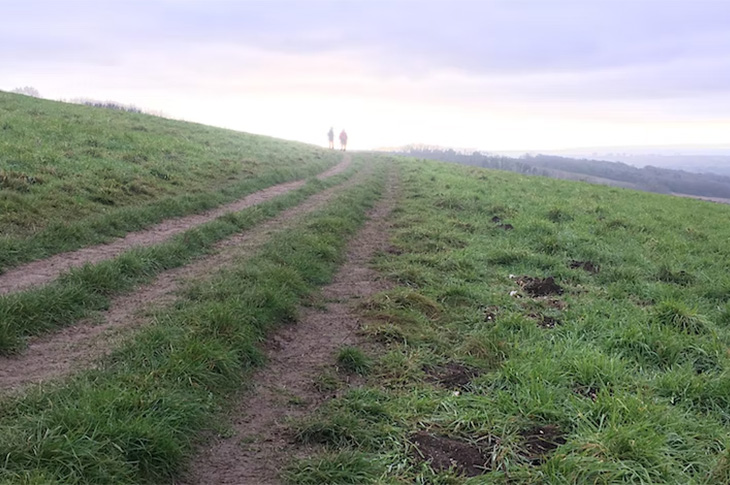
Thank you to everyone that came along to our group walks on the South Downs in January and February (which were run by Creative Waves Community Arts, focussing on our wellbeing, funded by Natural England).
Do you know you can easily walk to Highdown Gardens in 30/40 mins from Angmering, Durrington or Goring-by-Sea?

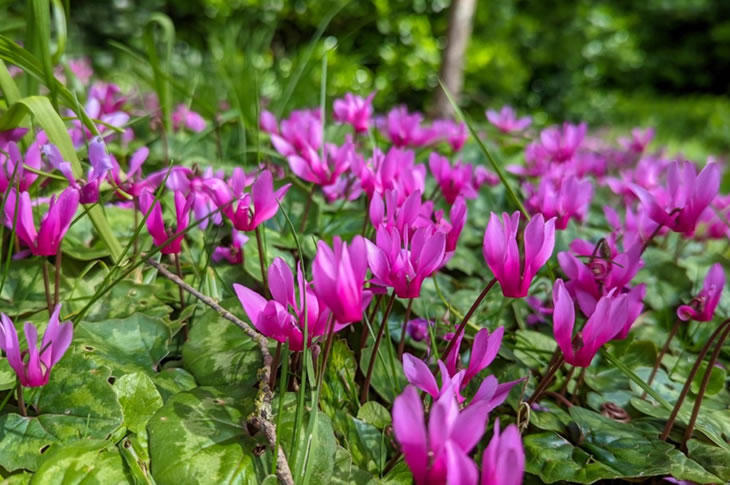
For this month’s Plant Focus blog Dee, Highdown’s Volunteer Visitor Assistant, writes about the Highdown’s Cyclamen collection.
As a volunteer I am lucky enough to see the Gardens through every season, and even though the summer blooms have faded there is still much to see and admire in the garden. In my recent session, I was taken by the beautiful and delicate cyclamen that are now sprouting up, they seem almost otherworldly.
One rare species at Highdown is Cyclamen repandum, which came from a rugby-playing botanist Hiatt Cowles Baker, who found it in Corsica in the 1920s. They favour the edges of the woodland and can be seen in the lower rose garden and the middle garden. The Cyclamen repandum won’t be flowering until next Spring, however there are lots of varieties to see in the garden now including:
If you have the opportunity, do come and see the cyclamen for yourselves. The staff and volunteers will give you a warm welcome, and you can take the time to enjoy the beauty and serenity of the garden, now putting on its autumn cloak and preparing for winter.
Photo of Cyclamen repandum (credit: Alex New)

Photos of Cyclamen hederifolium and close up of the flowers (credit: Alex New)
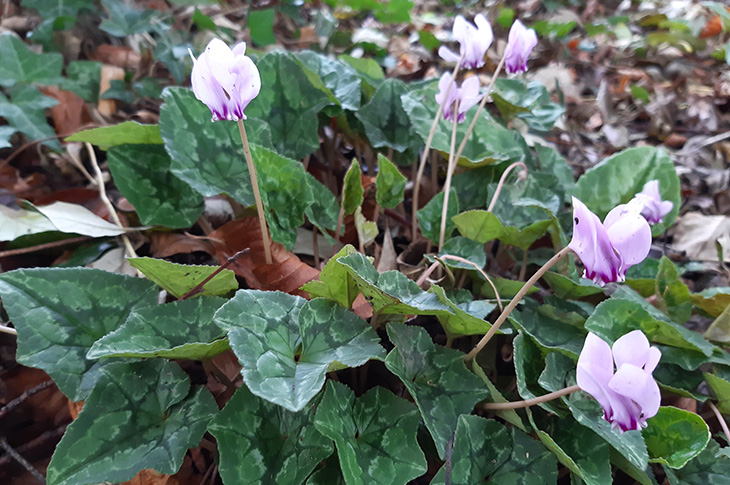
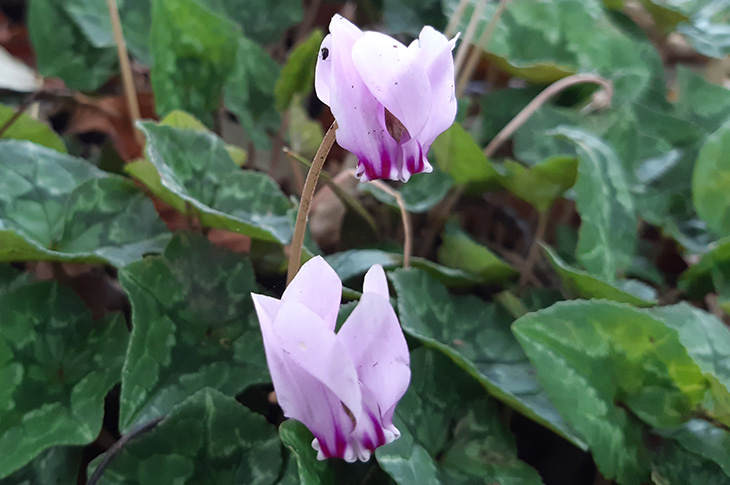
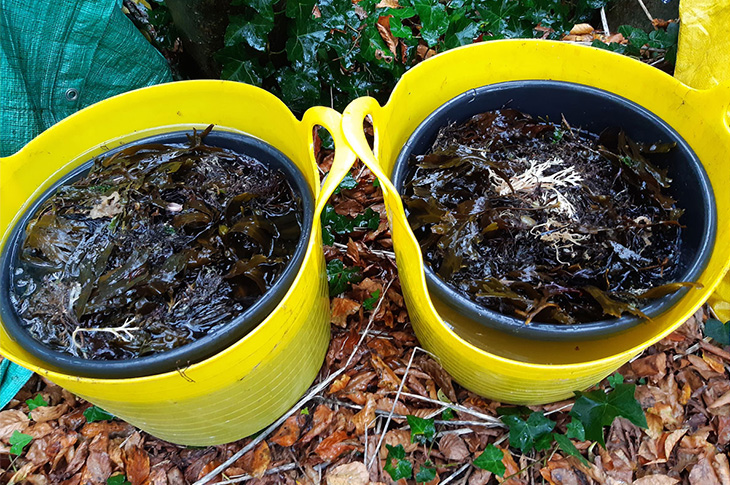
“Collected on the coast – Brewed on the hill”
The making of Highdown Seaweed Tea.
Have you seen the movie The Field, starring Richard Harris? It’s the story of a struggle over a field, transformed over generations from a rugged clifftop area into a fertile pasture abundant with crops, by improving the soil with seaweed hauled up from the beach below.
Hi, I’m Toby, a Craft Gardener up at Highdown, and I began my own exploration into the benefits of Seaweed Tea at the end of January this year.
After previously chatting with my colleague Rob, leader of the Foreshore team, and then completing the necessary Risk Assessments, I was clear to start gathering the dried seaweed on the high tide line of our shingle beach.
In about an hour I had filled two bulk bags half full (one full bag being too heavy to lift safely, thank you Risk Assessment) I loaded them into my car, then drove up the hill to work and to start brewing.
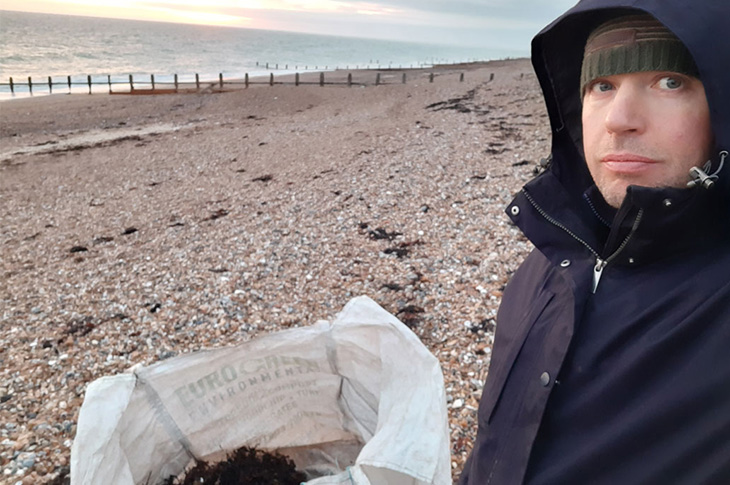
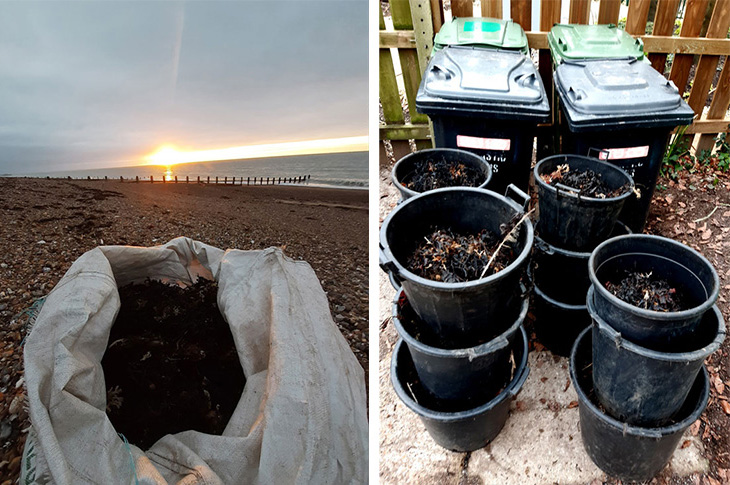
I put the seaweed into 12 large old plastic plant pots and then into four household wheelie bins, I’d got from my colleagues in the Refuse Department. Then, with a hose, filled the bins halfway with water to cover the seaweed buckets. Then I had a cup of tea (not seaweed) and waited. Hoping for the magic to happen and have the brew ready for the new growing season starting in spring.

The benefits of Seaweed Tea are numerous, as Monty Don often extols on Gardeners World, so I’ve been very interested to discover more about this natural resource, we’re lucky to have on our doorstep.
Long before commercial fertiliser production, seaweed had been used to aid plant growth. Providing many benefits to plants way beyond the capabilities of artificial fertilisers.
It promotes stronger, healthier plants which are better able to cope with environmental stresses, including flooding, drought, salinity, pests and diseases.
No doubt, it’s a tool all gardeners should have up their sleeve.
After 12 weeks’ fermentation, as April drew to a close and May brought warmer weather, so the brew was ready. I removed the buckets and drained off the pale green liquid and smelt the strong healthy odour which gave a reassuring nose of goodness, then poured and stored it into an old water butt.
Once a week since, I’ve been diluting the tea, one-part seaweed to ten water, then feeding all the new plantings I’d introduced to the garden, including annuals, herbaceous perennials, woody shrubs and trees.
But how would I really know if the seaweed tea has increased their health and vigour? As I wondered what to do with the free seeds supplied with the Gardeners World magazine, the idea came to me. Sow the basil, parsley, lettuce and Zinnia seeds and when they’ve germinated pot them up into two identical groups, feeding one with the Seaweed Tea and a control sample fed only with water.
So, on 15th June 2022 the two samples look similar, but what will the results show in three months’ time? Hopefully, the proof will be in the brew…
Photo: Growing experiment – plants fed with only water
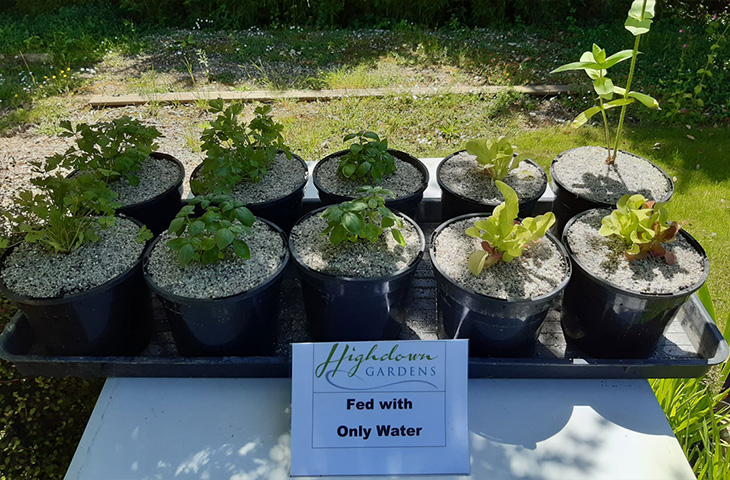
Photo: Growing experiment – plants fed with seaweed tea
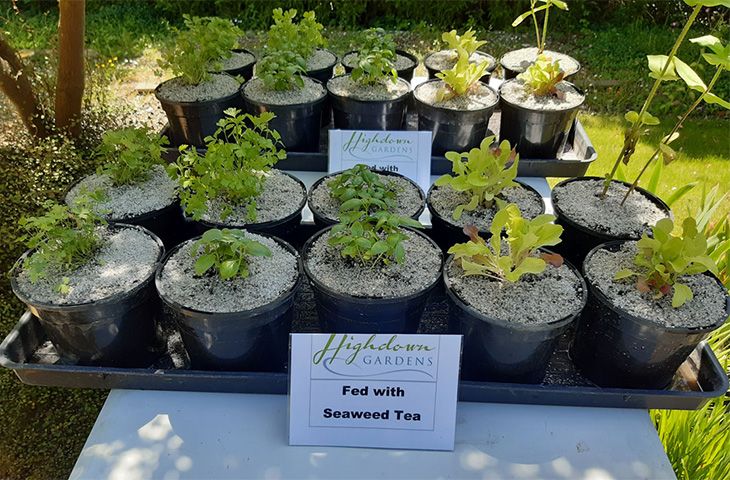
Note from the Worthing Coastal Office: What Toby from Highdown Gardens is doing is very small scale and a pilot scheme for exploiting ways to potentially utilize and deal with any large seaweed deposits in the future. As it stands, so long as the seaweed is for personal use, floating and un-attached then it is ok to harvest.
Crown Estate webpage quote: Seaweed collection for personal use, in small qualities does not require a licence. However, we would recommend that anyone doing so takes account of the environmental sensitivities of collecting anything from the wild.
If you have any questions about seaweed collection please contact the Worthing Coastal Office coastal.office@adur-worthing.gov.uk